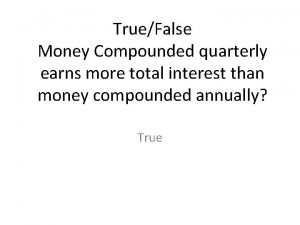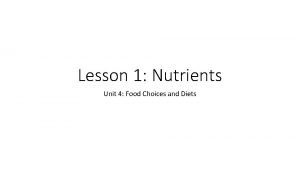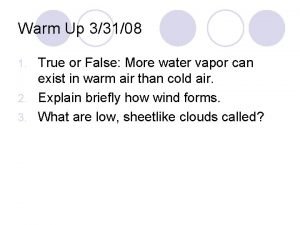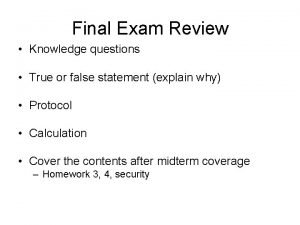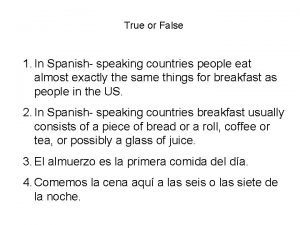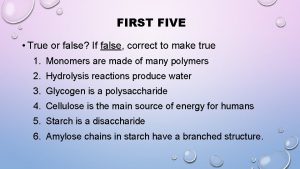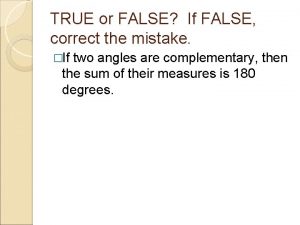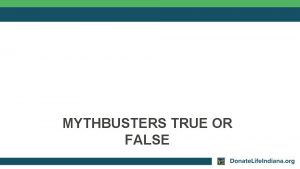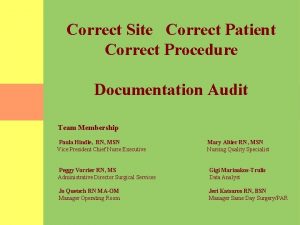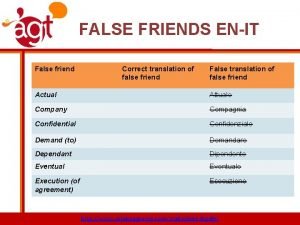Do Now True for False if false correct


















- Slides: 18

Do Now- True for False if false, correct the statement. p p p 1. Certain acquired characteristics, such as mechanical or mathematical skill may be inherited. 2. Certain thoughts or experiences of a mother mark or alter the hereditary makeup of an unborn child. 3. Color blindness is more common in males than in females. 4. A person may transmit characteristics to offspring which he/she does not show. 5. Certain inherited traits may be altered by the stars, planets or moon early in development. 6. The total number of male births exceeds female births each year.

Genetics Chapter 10. 2, 10. 3, 11. 1, and 11. 2

1866 Gregor Mendel “Father of Genetics” p Austrian Monk that studied pea plants p n n Pure breeds Self Fertilization p Statistician who wanted to be a teacher p Discovered how traits were inherited in a population

How Genetics Began p The passing of traits to the next generation - inheritance or heredity. p Mendel performed cross-pollination in pea plants. p Mendel followed various traits in the pea plants he bred.

7 Traits Mendel Studied

Mendel studied seven different traits. Seed or pea color p Flower color p Seed pod color p Seed shape or texture p Seed pod shape p Stem length p Flower position p

Mendel’s Crosses p P Generation: p F 1 Generation: p F 2 Generation:

Generations p P Generation – the parent generation n n p F 1 Generation – the offspring or generation produced by the P Generation n p Parents Pure Hybrid – 2 different types of genes for a trait F 2 Generation – the offspring or generation produced by the F 1 Generation n 3: 1–Yellow : Green

Definitions p Genetics: n p Gene: n p Study of hereditary Strand of DNA that codes for a protein (Trait) Allele: n A version of a gene

Phenotype vs. Genotype p Phenotype: n n p Physical characteristics (What the individual looks like) Ex) Red Petals Genotype: n n Alleles Received (genes you have) Ex) RR

Homozygous and Heterozygous p Homozygous: n p Having two of the same alleles for a particular trait Heterozygous: n Having two different alleles for a particular trait

Dominant Vs. Recessive p Dominant gene is represented by a capital letter n p Recessive gene is represented by a lower case letter n p Example - T Example - t Dominant hides the recessive trait in the heterozygous genotype n Example – T=Tall and t=short p A person with the genotype Tt would be Tall but they would also carry the short gene to pass on to offspring.

Think – Pair - Share p p p If Fred Flintstone is heterozygous for black hair. (B=Black, b=blonde) n What is Fred’s genotype? n What is Fred’s phenotype? Tweety bird is yy. (Y= yellow feathers, y=brown feathers) n 1. What is his genotype? n 2. What is his phenotype? n 3. Is he heterozygous or homozygous? Explain.

Mendels 3 Laws p 1. Law of Segregation n n Each allele a person has separates into different gametes Ex. Rr – one R goes in one sperm and the other r goes into another sperm r r R R Sperm

Mendels 3 Laws p 2. Law of Independent Assortment n Gene pairs (homologous) will separate randomly into gametes

Mendels 3 Laws p 3. Law of Dominance n n Traits exist in two possible forms (dominant and recessive) The dominant forms hides the recessive trait in the heterozygous condition

Genotypic vs. Phenotypic Ratios p Phenotype Ratio: n n p Ratio of different physical traits Ex) Brown eyes ¼ or 25% Genotype Ratio: n n Ratio of the different possible alleles Ex) Tt = ¼ or 25%

Monohybrid Cross R= Can roll your tongue p r= Can’t roll your tongue p p Genotype Ratio: n n n p R RR = 1: 3 or 25% Rr = 2: 2 or 50% Rr = 1: 3 or 25 % Phenotype Ratio: n n r R RR Rr rr Can roll tongue = 3: 1 or 75% Cant roll tongue = 1: 3 or 25%
 True or false true or false
True or false true or false Choose the correct item how long
Choose the correct item how long Now i see it now you don't
Now i see it now you don't Slidetodoc
Slidetodoc True and false disciples meaning
True and false disciples meaning True or false questions about leadership
True or false questions about leadership A method to make regular saving easier is ____.
A method to make regular saving easier is ____. Function of niacin
Function of niacin Sign chapter 37
Sign chapter 37 Measurements
Measurements Boolean operators truth tables
Boolean operators truth tables True maps false impressions
True maps false impressions How to answer true or false questions
How to answer true or false questions Blue is a warm color true or false
Blue is a warm color true or false False and true vocal cords
False and true vocal cords True/false
True/false Los pasteles son muy _____ para la salud.
Los pasteles son muy _____ para la salud. Rates of reaction quiz
Rates of reaction quiz Finance true/false questions
Finance true/false questions






